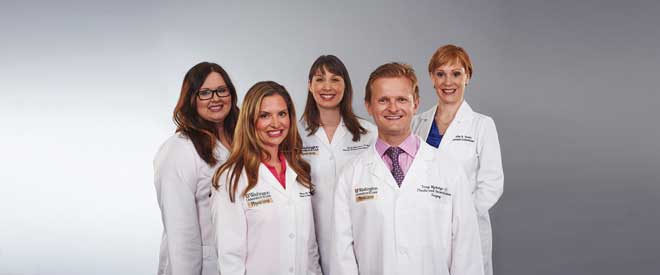Breast augmentation is the most popular cosmetic surgery procedure in the United States, with more than 290,000 surgeries performed last year. “Some women just want to add a few curves; some come in for a ‘mommy makeover’ following pregnancy and breastfeeding,” says Dr. Marissa Tenenbaum of West County Plastic Surgeons of Washington University. “Others opt for reconstruction following a mastectomy.” Tenenbaum and her colleague, Dr. Terry Myckatyn, both board-certified plastic and reconstructive surgeons, offer a full range of procedures to help women look and feel better—and the expertise to ensure the best possible outcome.
Advances in design and technology allow cosmetic surgeons to achieve beautiful, more natural-looking results than ever before, Tenenbaum says. Anatomically shaped (or ‘gummy bear’) implants, made of dense silicone gel, are designed to mirror a woman’s natural curves. “Traditional round implants have more volume in the upper breast area, but shaped implants have a gradually tapered slope, like a teardrop,” she explains. Allergan, Sientra and Mentor, three leading implant manufacturers, now offer FDA-approved versions. “Shaped implants aren’t necessarily better than round ones,” she adds. “It’s all about deciding what’s right for you, based on your body type and desired result.”
To help patients choose, West County Plastic Surgeons offers the VECTRA, a 3-D imaging system that captures a 180-degree image of the face, breasts and torso from many angles. “The VECTRA simulates how patients will look with various styles and sizes of implants, or with a breast lift and/or reduction,” Tenenbaum says. Recently added software also give patients a preview of rhinoplasty, chin implant and liposuction results. “The simulations are quite realistic, so it’s a valuable tool that helps doctor and patient communicate,” she adds.
Not every patient’s skin is strong enough to hold an implant in position, Myckatyn notes. “Pregnancy, breast feeding, or rapid weight loss can weaken or stretch tissue, resulting in implants that droop or slip to the side,” he says. The SERI surgical scaffold, a new product from Allergan, bolsters weak tissue and holds implants in place. “Inserted during the initial augmentation procedure, or during revision surgery to raise implants that have fallen, the silk-based, mesh scaffold reinforces and stabilizes the area, removing pressure from the skin,” he explains. “The patient’s body slowly absorbs the material, which eventually is replaced by strong, healthy collagen tissue. So the support remains even after the scaffold is gone.”
Washington University is conducting ongoing studies on patient satisfaction with breast augmentation following VECTRA imaging and usage of the SERI surgical scaffold. “West County Plastic Surgeons is a phenomenal place to work,” Tenenbaum says. “We offer a patient-centered atmosphere, innovative procedures, and Washington University’s worldwide reputation for medical and research expertise. From the moment you walk in, it’s all about you—your comfort and safety, your confidence in your procedure, and your satisfaction with the results.”
Pictured: Licensed aesthetician Kristi Reasons-Look, Dr. Marissa Tenenbaum, certified physician assistant Emily Weinhaus, Dr. Terry Myckatyn, licensed aesthetician Kristin Green
Photo Courtesy of Washington University Physicians
[West County Plastic Surgeons of Washington University is located at 1040 N. Mason Road, Ste. 124. For more information, call 314.996.8800 or visit westcountyplasticsurgeons.wustl.edu.]
